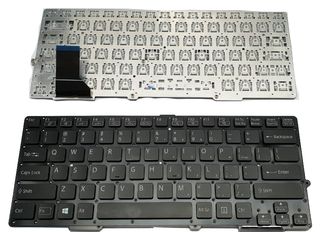

The Vaio T13112FXS's integrated battery ran well, topping 5 hours and 42 minutes in our battery-drain test. (The Intel white box played Street Fighter IV at 21 frames per second). Quad-core Ivy Bridge CPUs exhibited better graphics performance, but it's a different story here in ultrabook-land. Diablo III ran at about 16 frames per second with graphics set to low.
Sony vaio s series svs1311f3e 13.3 laptop white Pc#
That's not exactly a massive leap, and it doesn't get this laptop to the point where it can play mainstream PC games easily, or even well. One of the first ultrabooks with a hybrid hard drive we reviewed last year, the Acer Aspire S3, ran that same SFIV test at 11.9 fps. Street Fighter IV played at 15.1 frames per second at native 1,366x768 resolution and 2x AA. Intel's much-heralded improved HD 4000 integrated graphics provide an improvement over last year's HD 3000 graphics, but it didn't seem like a quantum leap on this ultrabook. Graphically, however, I was a bit disappointed. It's still a zippy machine, even if its boot times don't rock your socks off. The Vaio T woke from sleep more rapidly, taking about 3 seconds. This Vaio T also performed a little more slowly than the last Vaio SB and Vaio Z units we reviewed this spring, but that's to be expected: those had full-voltage second-gen Core i5 processors, too.īoot-up times were reasonably quick - about 27 seconds by my stopwatch - but not as fast as on an SSD laptop like the Samsung Series 9 or MacBook Air. This system doesn't outperform a last-gen full-voltage Core i5 laptop like the Toshiba Portege R835-P88, but it comes closer. Yes, it's a faster ultrabook, and speeds are getting to the point where you won't really miss having a "full-voltage" mainstream dual-core processor much at all. The Vaio T13112FXS performed better than the 13-inch Samsung Series 5 Ultra we recently reviewed, the 15-inch Samsung Series 9, and the Toshiba Portege Z835. It performed more slowly on benchmark tests than the Asus Zenbook UX32V, which had an even better Core i7-3517U CPU.Ĭompared to ultrabooks with Sandy Bridge second-generation Intel processors, there's a definite but modest improvement.

The 1.7 GHz Core i5-3317U processor compared favorably to the Intel ultrabook "white box" we received at CNET, which had a slightly faster and better-performing 1.8 GHz Core i5-3427U processor. This is the first third-gen Intel Ivy Bridge ultrabook I've reviewed, and the experience was positive, if somewhat uninspiring. I prefer hybrid hard drives until SSDs can get large enough (256 or 512GB) to avoid compromise. Including hybrid hard drives with larger storage capacities and small amounts of fast-loading SSD flash storage instead of more expensive full-size SSDs is a trend you can bank on seeing on many budget ultrabooks this year: it cuts the cost of the system, and arguably offers the benefit of more space for your media. The fixed $769 configuration of the Vaio T13112FXS I reviewed has 4GB of RAM, a 1.7 GHz third-gen Core i5-3317U processor, and a 500GB hybrid hard drive with an additional 32GB SSD.


 0 kommentar(er)
0 kommentar(er)
